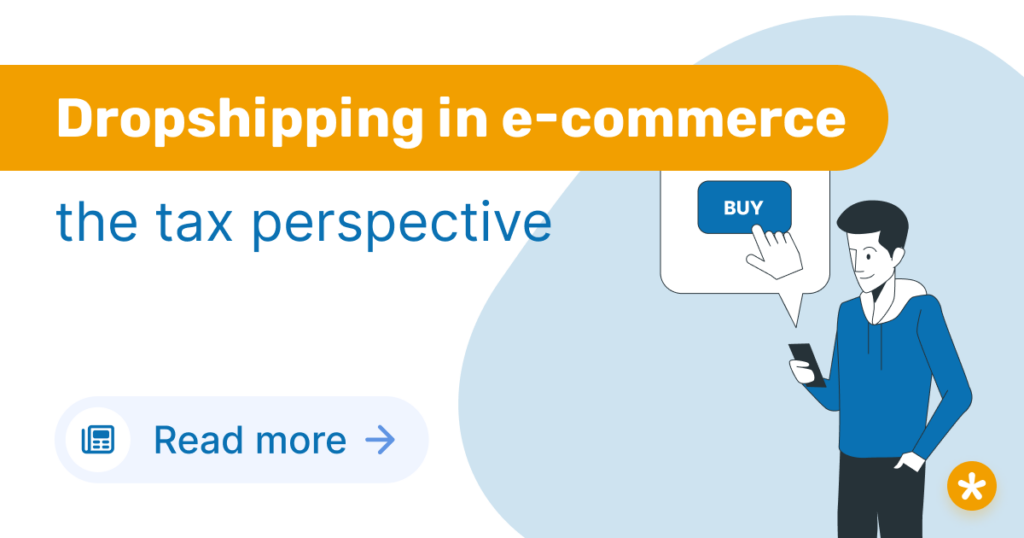
Are you already familiar with the “dropshipping in e-commerce” model? The possibilities in e-commerce today are virtually unlimited. A listing on one of the well-known marketplaces already takes a lot of work off your hands. You don’t have to create your own online store and can theoretically get started right away by simply listing your products.
With your own store, this looks a little different. Often ready-made templates help to a “standard design”, but it is the individuality and the personality, why you decide for your own way in e-commerce.
Dropshipping is nowadays an excellent option for many sellers to enter the market. What you should consider here, however, also fiscally, we list in this blog.
Table of contents
Difference dropshipping in e-commerce and external fulfillment
Dropshipping must be distinguished from external fulfillment. External fulfillment would mean that you, as the seller of the goods, store them with a service provider and have them shipped. The prerequisite here would be that you actually purchase the goods in advance and then send them to your service provider.
The service provider takes over the warehousing and the management of the shipment. You save on the fixed costs of staff and also the premises of the warehouse, however you are responsible for the usage fees of the fulfillment service. Amazon, for example, also offers external fulfillment through its CEE and PAN EU programs.
The benefits of dropshipping
The dropshipping model is an attractive option for shipping goods for many newcomers to e-commerce, but also for “old hands” in the business. At least at first glance, there are some advantages:
Lower investment costs
Compared to traditional retail, dropshipping sellers don’t have to buy goods in advance or even store them. Instead, you often have the option to order the products directly from the supplier when an order is received from a customer. This can significantly reduce investment costs and you run less risk of being “stuck” with your already purchased goods in the worst case scenario.
No storage space required
Since dropshipping sellers do not have to buy and store goods in advance, they do not need physical storage space. This not only saves space, but also the costs of storage, inventory management, and not inconsiderable personnel costs.
Flexibility and scalability
Since dropshipping sellers don’t have to store physical goods, they can be more flexible and offer a wider range of products without worrying about inventory and shipping. Offer a wide range of products that are profitable for you and your business. Test for your business whether additional distribution channels make sense and generate additional sales markets. Test all the options available to you here and choose the best way for you.
Easy market entry
Since there is no need for significant investment in warehousing and purchasing of goods, dropshipping sellers can enter the market quickly and easily without incurring high initial costs.
Overall, the dropshipping model offers sellers a number of advantages that can make it an attractive model for entering e-commerce.
Save the date:
Webinar on 16.05.2023
at 3:00 p.m.
about dropshipping

Do you have questions about dropshipping that you’ve always wanted to ask an expert? In internet forums you can find a lot of answers from other sellers or experience reports, but we would still recommend you to get coverage from a professional.
To that end, we’re offering a webinar on 5/16/2013 at 3:00 p.m., where we’d like to address your questions in particular.
Register right here: Go to webinar registration
Dropshipping in e-commerce – tax hurdles and special features
Despite all the advantages of the dropshipping model, there are also some hurdles and peculiarities regarding the tax aspects. As a seller, you should be aware of these particularities and, in the best case, consult a tax advisor before you start dropshipping.
In our opinion, we have summarized the most important points for you.
Sales tax in dropshipping
With dropshipping, it can be difficult to calculate sales tax correctly because the goods are delivered directly from the supplier to the end customer. Even if you are not dropshipping the goods yourself, you should check what sales tax obligations, such as local tax registrations, you have. Additionally, check what tax rates apply to the goods you are selling.
Think about customs and import sales tax
When a seller sells internationally, he may also have to pay customs duties and import VAT. It is important that he is aware of what rules and regulations apply to the export of goods and what costs he will incur. Even in dropshipping, you should discuss any special conditions or fees here with the responsible entrepreneur so that you are not surprised by the costs.
What you should know about taxes in other countries
If you sell goods internationally, it may of course also be the case that you are also liable to pay tax in these countries. For example, you may have another company headquarters there or an additional warehouse of your own. A tax registration is therefore available to you. If necessary, discuss with your dropshipper whether there are any special tax principles to be considered when you sell goods in these countries.
Important for your accounting
It is important that you, as a seller, keep accurate accounts and carefully record all transactions that go through your dropshipper, as well as all costs. This will ensure that all taxes can be calculated and paid correctly at all times.
No contract commitment. No need to provide payment information.
Conclusion
Overall, a seller who dropships and sells internationally should thoroughly inform themselves about the tax hurdles and specifics and ensure that they comply with all relevant rules and regulations. Good accounting and compliance are essential in order to calculate and pay taxes correctly.
Read also:
Working from Home – Pros and Cons
Effective mangement of business documents: Document types in easybill
6 excellent tips for shipping management: E-commerce made easy in easybill


